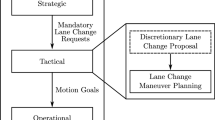Abstract
Lane changes are made frequently on the road and are therefore an important component in analyzing traffic situations. This behavior interferes with surrounding traffic, causes negative shockwaves, and may even lead to collisions. Lane changes can be categorized into mandatory lane changes and discretionary lane changes. There are various factors influencing the decision-making involved in discretionary lane changes, including relative velocity between target and original lane, and lead and lag gaps. The purpose of this paper is to present a stochastic approach for modeling discretionary lane changes with influential factors of velocity and spacing advantages. Using Next Generation Simulation (NGSIM) data, we proposed an exponential probability model with speed difference and lead gap difference between the target lane and the original lane. By transformed linear regression, these traffic variables have actual influences on the lane change probability of discretionary lane changes. The found results can be used for lane change models in microscopic traffic simulation.
Similar content being viewed by others
References
Cassidy, M. and Bertini, R. (1999). “Observations at a freeway bottleneck.” Proceedings of the 14th International Symposium on Transportation and Traffic Theory, Pergamon, New York, pp. 107–146.
Chang, G. and Kao, Y. (1991). “An empirical investigation of macroscopic lane-changing characteristics on uncongested multilane freeway.” Transportation Research Part A, Vol. 25, No. 6, pp. 375–389, DOI: 10.1016/0191-2607(91)90015-I.
Choudhury, C., Ben-Akiva, M., Toledo, T., Lee, G., and Rao, A. (2007). “Modeling cooperative lane changing and forced merging behavior.” Proceedings of the 86th Transportation Research Board Annual Meeting, Washington, DC.
Daganzo, C. (2002). “A Behavioral theory of multi-lane traffic flow, part II: Merges and the onset of congestion.” Transportation Research Part B, Vol. 36, No. 2, pp. 159–169, DOI: 10.1016/S0191-2615(00)00043-6.
Federal Highway Administration (2006). Next Generation Simulation Program (NGSIM).
Gipps, P. (1981). “A behavioral car-following model for computer simulation.” Transportation Research Part B, Vol. 15, No. 2, pp. 105–111, DOI: 10.1016/0191-2615(81)90037-0.
Gipps, P. (1986). “A model for the structure of lane-changing decisions.” Transportation Research Part B, Vol. 20, No. 5, pp. 403–414, DOI: 10.1016/0191-2615(86)90012-3.
Goswami, V. and Bham, G. (2007). “Gap acceptance behavior in mandatory lane changes under congested and uncongested traffic on a multilane freeway.” Proceedings of the 86th Transportation Research Board Annual Meeting, Washington, DC.
Hidas, P. (2002). “Modeling lane changing and merging in microscopic traffic simulation.” Transportation Research Part C, Vol. 10, No. 5-6, pp. 351–371, DOI: 10.1016/S0968-090X(02)00026-8.
Hidas, P. (2005). “Modeling vehicle interactions in microscopic simulation of merging and weaving.” Transportation Research Part C, Vol. 13, No. 1, pp. 37–62, DOI: 10.1016/j.trc.2004.12.003.
Jin, W. (2010). “A kinematic wave theory of lane-changing vehicular traffic.” Transportation Research B, Vol. 44, No.s 8-9, pp. 1001–1021, DOI: 10.1016/j.trb.2009.12.014.
Knoop, V., Hoogendoorn, S., Yasuhiro, S., and Buisson, C. (2012). “Quantifying the number of lane changes in traffic: Empirical analysis.” Transportation Research Record, Vol. 2278, pp. 31–41, DOI: 10.3141/2278-04.
Laval, J. and Daganzo, C. (2005). “Multi-lane hybrid traffic flow model: a theory on the impacts of lane-changing maneuvers.” Proceedings of the 84th Transportation Research Board Annual Meeting, Washington, DC.
Laval, J. and Daganzo, C. (2006). “Lane-changing in traffic streams.” Transportation Research. Part B, Vol. 40, No. 3, pp. 251–264, DOI: 10.1016/j.trb.2005.04.003.
Laval, J. and Leclercq, L. (2008). “Microscopic modeling of the relaxation phenomenon using a macroscopic lane-changing model.” Transportation Research Part B, Vol. 42, No. 6, pp. 511–522, DOI: 10.1016/j.trb.2007.10.004.
Li, S., Wu, Y., Xu, Z., and Lin, X. (2014). “Improved lane-changing model for vanets in SUMO.” In Advanced Infocomm Technology, 2014 IEEE 7th International Conference on, pp. 260–266, DOI: 10.1109/ICAIT.2014.7019563.
Oh, S. and Yeo, H. (2015). “Impact of Stop-and-Go waves and lane changes on discharge rate in recovery flow.” Transportation Research Part B, Vol. 77, pp. 88–102, DOI: 10.1016/j.trb.2015.03.017.
Park, M., Jang, K., Lee, J., and Yeo, H. (2015). “Logistic regression model for discretionary lane-changing under congested traffic.” Transportmetrica A: Transport Science, Vol. 11, No. 4, pp. 333–344, DOI: 10.1080/23249935.2014.994686.
Thiemann, C., Treiber, M., and Kesting, A. (2008). “Estimating acceleration and lane-changing dynamics from next generation simulation trajectory data.” Transportation Research Record, Vol. 2088, No. 1, pp. 90–101, DOI: 10.3141/2088-10.
Toledo, T. and Zohar, D. (2007). “Modeling duration of lane changes.” Transportation Research Record, No. 1999, No. 1, pp. 71–78, DOI: 10.3141/1999-08.
Toledo, T., Koutsopoulos, H., and Ben-Akiva, M. (2003). “Modeling integrated lane-changing behavior.” Transportation Research Record, Vol. 1857, No. 1, pp. 30–38, DOI: 10.3141/1857-04.
Wiedemann, R. and Reiter, U. (1992). “Microscopic traffic simulation: The simulation system MISSION, background and actual state.” Project ICARUS (V1052) Final Report, Vol. 2, pp. 1–53.
Yeo, H. (2008). Asymmetric microscopic driving behavior theory, PhD dissertation. University of California, Berkeley.
Yeo, H. and Skabardonis, A. (2008). “Parameter estimation for NGSIM freeway flow algorithm.” Proceedings of the 10th Conference on Application of Advanced Technologies, Athens, Greece, ASCE, New York.
Yeo, H., Shladover, S., Krishnan, H., and Skabardonis, A. (2010). “Microscopic traffic simulation of vehicle-to-vehicle hazard alerts on freeway.” Transportation Research Record, Vol. 2189, No. 1, pp. 68–77, DOI: 10.3141/2189-08.
Yeo, H., Skabardonis, A., Halkias, J., Colyar, J., and Alexiadis, V. (2008). “Oversaturated freeway flow algorithm for use in next generation simulation.” Transportation Research Record, Vol. 2088, No. 1, pp. 68–79, DOI: 10.3141/2088-08.
Zhang, P. and Kovvali, V. (2007). “Freeway gap acceptance behaviors based on vehicle trajectory analysis.” Proceedings of the 86th Transportation Research Board Annual Meeting, Washington, DC.
Author information
Authors and Affiliations
Corresponding author
Rights and permissions
About this article
Cite this article
Lee, J., Park, M. & Yeo, H. A probability model for discretionary lane changes in highways. KSCE J Civ Eng 20, 2938–2946 (2016). https://doi.org/10.1007/s12205-016-0382-z
Received:
Accepted:
Published:
Issue Date:
DOI: https://doi.org/10.1007/s12205-016-0382-z




